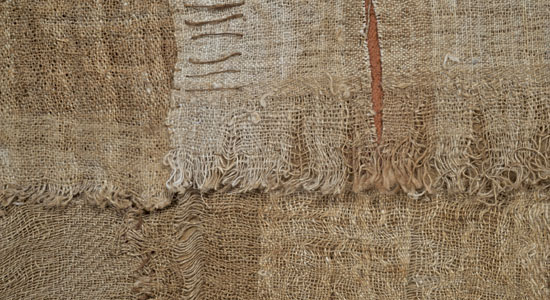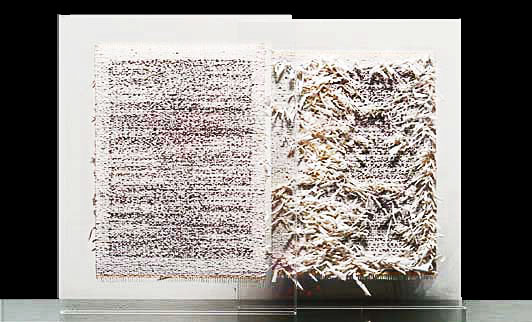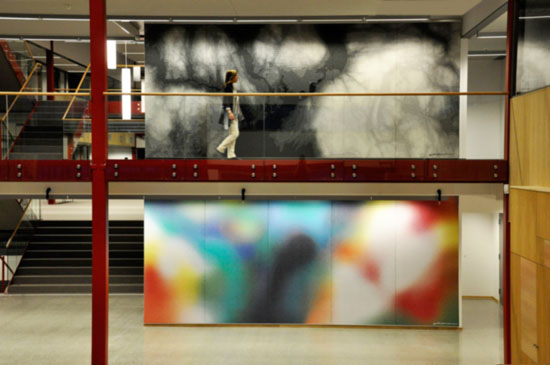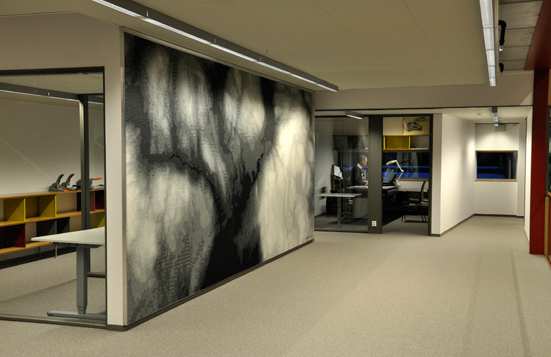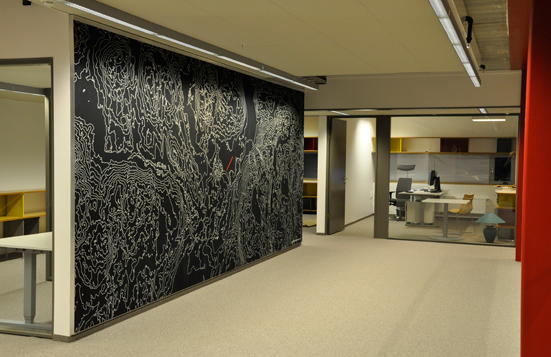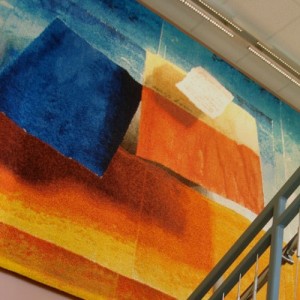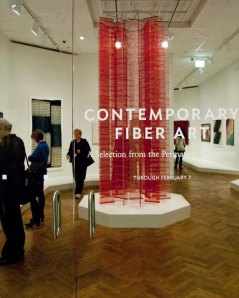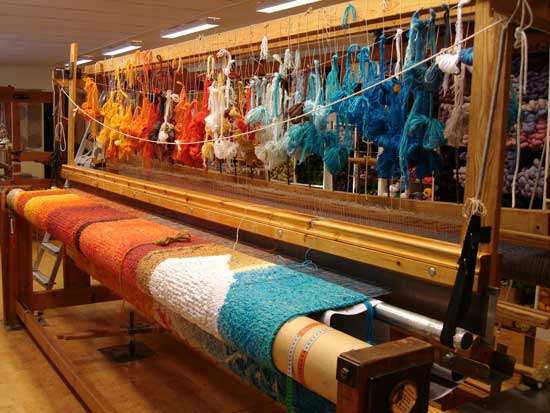25 at 25 at SOFA NY Countdown: Susie Gillespie
Art into Text: Naomi Kobayashi’s Work Inspires a Plot Twist
William Bayer, author of  The Dream of the Broken Horses,
The Dream of the Broken Horses,  Switch,
Switch,  Peregrine and Punish Me With Kisses, among other titles, has woven Naomi Kobayashi’s art into his upcoming novel – working title, In the Weave. Bayer is a collector of Kobayashi’s art work — weavings of thread and strips of washi paper on which she has written calligraphy. For his new book, Bayer envisioned a character with a secret recorded on paper that she protects by cutting the pages into strips and incorporating it into a weaving, which is then unraveled so the paper strips can be steamed and pieced back together to reveal the secret. When contacted for her advice, Kobayashi agreed that a weaving of paper strips and thread could be de-constructed and de-coded as Bayer planned; the paper strips would survive steaming and unraveling, she wrote, because handmade washi paper is strong. She worried, however, that the ink might blur during steaming and suggested that Bayer’s character use oil-based ink.
Peregrine and Punish Me With Kisses, among other titles, has woven Naomi Kobayashi’s art into his upcoming novel – working title, In the Weave. Bayer is a collector of Kobayashi’s art work — weavings of thread and strips of washi paper on which she has written calligraphy. For his new book, Bayer envisioned a character with a secret recorded on paper that she protects by cutting the pages into strips and incorporating it into a weaving, which is then unraveled so the paper strips can be steamed and pieced back together to reveal the secret. When contacted for her advice, Kobayashi agreed that a weaving of paper strips and thread could be de-constructed and de-coded as Bayer planned; the paper strips would survive steaming and unraveling, she wrote, because handmade washi paper is strong. She worried, however, that the ink might blur during steaming and suggested that Bayer’s character use oil-based ink. 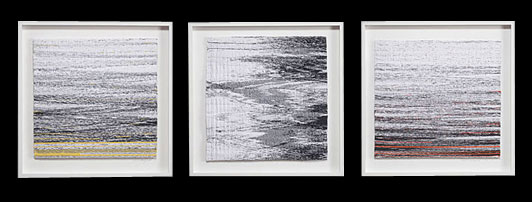 We’ll let you know when the book is ready to hit bookstore shelves. In the meantime. We’ve gotten Bayer’s permission to share a snippet of what’s to come:
We’ll let you know when the book is ready to hit bookstore shelves. In the meantime. We’ve gotten Bayer’s permission to share a snippet of what’s to come:
From In the Weave, by William Bayer:
Kate and I are up in the A.I.R. loft. Liv’s weaving is spread out before us, reminding me of that T. S. Eliot line “like a patient etherised upon a table.” In fact, we have set TPR on the apartment dining table, and beside it have set out our instruments: scissors, needles, tweezers. Surgery is about to commence.
Kate smiles. “Nervous?”
“How can I not be?”
“I think you should make the first cut,” she says.
I nod, gaze down at the weaving, so beautifully finely made. And then I take the scissors in hand, and begin.
We’ve discussed this deconstruction process at great length, and though we’re not certain if we’re right, we’ve decided to start by scissoring off the top selvage, snip the cotton warp in numerous places to try and loosen the weave, then pluck out the first several washi paper wefts. It’s our hope that if we steam these wefts, they’ll open up and flatten out. Then and only then will we be able to determine if there’s writing on them. If there is, we’ll repeat the process hundreds of times until we’ve removed and steamed open all the strips, and then try, as puzzle solvers, to reassemble these strips until we’ve reconstructed the original sheet of paper. Only then will we be able to read whatever Liv may have written on it. We know this process will be laborious, will take us many hours, and may, in the end, come to nothing. In which case we will have destroyed her amazing work of art. But what choice do we have? If Liv did in fact “conceal my pain in the weave,” we must uncover it. And if she didn’t, we’ll be left with nothing but a heap of cotton thread and marked up paper strips, and a tremendous amount of remorse.
Installation News: Grethe Sørenson for Tronrud Engineering in Norway
In 2010, Danish artist Grethe Sørensen was commissioned to produce a site-specific, large-scale work of textile art for Tronrud Engineering in Hønefoss, Norway. Tronrud Engineering specializes in developing machinery within the industrial automation area. The firm’s new location, designed by Norwegian architects Snøhetta (Snoarc), is situated at Eggemoen, the largest natural flat plateau in Norway.
The work that resulted was Fjeld og li og fjord, a title taken from a quotation from a Danish song about Norwegian landscapes which means “mountain and meadow and fiord.” For the work’s motif, Sørensen took as a point of departure the contours of the landscape around Eggemoen, and rendered these contours in three variations on the same theme — Contour, Greyscale and Color — one theme for each floor in the building. The textiles are integrated into the structure of the building; placed opposite the entrance doors on three floors above each other covering walls of 15 square meters each. Each piece consists of 5 panels of jacquard-woven fabric.
The first floor shows a color fantasy of the landscape theme. This image is the first impression to visitors and it may be seen as an expression of the creativity that is one of the main characteristics of Tronrud Engineering. The second floor has the Greyscale. From a distance it gives a three-dimensional impression of the landscape. On closer inspection, it’s evident that it is made up of different patterns in black and white – typical digital patterns. These patterns reference Norwegian a traditional knitting pattern, “lusekofte,” a Norwegian sweater pattern, dating from the 19th century. It features a black-and-white design, and the name means “lice jacket,” after the isolated black stitches. The Greyscale motif represents tradition combined with innovation as an expression of the versatility and wide-ranging skills represented by the people in the company. On the third floor is the pure black-and-white image of the landscape with contours and a line in red. This piece expresses the sharpness, seriousness and precision for which the firm is known.
The samples were woven by Sørensen on a handloom with digital single-thread control. The final pieces were woven on an industrial jacquard loom at Digital Lab, at the Audax Textile Museum, Tilburg, Netherlands.
Dispatches: Helena Hernmarck’s Tabula Rasa at Purdue
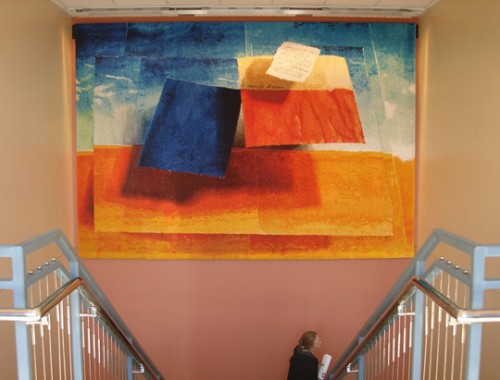
Helena Hernmarck’s Tabula Rasa at the Yue-Kong Pao Hall of Visual and Performing Arts at Purdue’s College of Liberal Arts
In 2009, Purdue University in West Lafayette, Indiana selected Helena Hernmarck to design and execute a tapestry for the Yue-Kong Pao Hall of Visual and Performing Arts at Purdue’s College of Liberal Arts. Lisa Lee Peterson, Professor and Graduate Director of Department of Art and Design, was instrumental in Hernmarck’s selection by the university art committee. “Of the artists working in tapestry today,” the University’s press materials quote Jack Lenor Larson, “Helena Hernmarck stands without peer. Her works have been selected for scores of prestigious public spaces and are seen each year by millions of viewers. The hallmark of Ms. Hernmarck’s work is her skill in creating the optical illusion of three-dimensional designs on flat but richly textured surfaces of tapestry.”

Helena Hernmarck and Lisa Lee Peterson in Front of Tabula Rasa at Purdue University. Photo by Skif Peterson
The University determined the location of the piece — the stairwell between the first and second floors — but left the other details to Hernmarck, who addressed two needs in her conception for the piece. She wanted the designed image to collectively represent the various art forms that are studied within the building — painting, ceramic, jewelry, textile, industrial design, theater, dance and music and she wanted the design to fit within the chosen area and increase the feeling of space in the stairwell.
Designed during the summer 2009, Hernmarck settled on a theme for the design: tabula rasa, the unwritten page, also a piece of ceramic that is scraped clean of marks after each use. Hernmarck’s Tabula Rasa would represent the beginning of the creative journey, whether at inception or at the commencement of an additional phase of the creative process. During sketching, Hernmarck often finds the road to a final design through a process of changes or “scraping away” of initial ideas in such a way that previous marks still become part of the overall design. The early phase of Tabula Rasa is referenced in the few words written on a white page woven in the tapestry.
Hernmarck achieved the feeling of space for the stairwell that she envisioned by painting and then photographing small cut-up pieces of watercolors so that they cast shadows creating an image of being in flight. This enabled her to place the smallest of the elements of Tabula Rasa closest to the plane of the image, i.e. the place with the most sense of urgency. The final design includes a play on shadows to create a visual illusion on different levels which solved the challenge of designing the lower portion of the work to catch the eye of a person walking up the staircase.
Alice Lund Textiles, Borlange, Sweden produced the tapestry. The main weavers were Britt-Marie Bertilsson and Ebba Bergstrom. Tabula Rasa is the twenty-first tapestry of Helena Hernmarck’s design and technique to be woven at Alice Lund Textiles since 1975. The weaving took 30 weeks from beginning to finish. During this time, Hernmarck visited the studio periodically in order to oversee the quality of the work and to participate in both the weaving and the dying process of the wool with its numerous variations, shades and values. The colors were custom dyed at Wålstedts Textile Spinning and Dying Workshop in Dala-Floda. For Tabula Rasa the workshop dyed 24 kg of wool in 41 different colors. Hernmarck prefers to use of a variety of different qualities in the spun wool, such as thin gobeline, gobelin with rya wool, and single-ply rya wool. The final work includes hundreds of different colors and textures. A video of the weaving of Tabula Rasa can be viewed at http://browngrotta.com/Pages/hernmarck.php.
Hernmarck’s unique technique combines different weaving methods and patterns with which she has experimented for more than 45 years. The Hernmarck tapestry technique creates a coarse texture much like the Impressionists’ painting style of the early 1900s. A full-scale enlargement of the image in black and white is created before beginning the tapestry. The cartoon is then adhered to the back side of the tapestry and draped over an aluminum tube that presses the cartoon up against the warp from underneath. The cartoon makes it possible to follow the forms and shadows that can be seen through the warp threads. In order to observe what the weaving will look like at a distance, the artist looks through a small pair of binoculars, turned backwards. While the tapestry is woven on the horizontal loom, only 50 cm of the tapestry can be viewed at one time. The ongoing action and reaction in changing colors and weaving techniques creates the overall beauty of the tapestry.
Dispatches: Sheila Hicks: 50 Years, Addison Gallery of American Art, Andover, Massachusetts
 It was the well worth the wait. The first museum retrospective of Sheila Hicks‘ remarkable career has opened at the Addison Gallery and will travel to additional venues in the next few years, including the Institute of Contemporary Art of Philadelphia next March 2011 and the Mint Museum of Craft + Design, Charlotte, NC in October 2011.
It was the well worth the wait. The first museum retrospective of Sheila Hicks‘ remarkable career has opened at the Addison Gallery and will travel to additional venues in the next few years, including the Institute of Contemporary Art of Philadelphia next March 2011 and the Mint Museum of Craft + Design, Charlotte, NC in October 2011.
The Addison is an ideal showcase for the expansive exhibition, which includes more than 100 works, journals, videos and photographs. The classic architecture of the gallery provides an ideal counterpoint for Hicks’ brilliantly colored soft sculptures, for the more formal panels of stitched medallions and linen pony tails and for the minimes, framed miniature works, from various decades that are featured throughout the exhibition. When we arrived at sundown, the building was bathed in golden light an inviting complement to La Mémoire, the brilliantly colored series of wrapped cords to the left of the entrance and Bamian, the larger jewel-toned installation that can be seen in the distance in the gallery down the corridor.
The exhibition is comprehensive, addressing the remarkable reach of Hicks’ artistic life, which has included learning sewing and embroidery as a child in Nebraska, studying painting with Josef Albers at Yale, weaving in South America on a Fulbright and site commissions for public spaces including the Ford Foundation and Georg Jensen in New York, the Target corporate headquarters in Minneapolis, the Fuji City Cultural Center in Japan and the Banco de Mexico headquarters, with architect Ricardo Legorreta. In addition, Hicks has also published a magazine, created designs for commercial production, taught, founded workshops in Mexico, Chile, and South Africa, worked in Morocco and India, pursued interior and exterior architecture, sculpture, photography, book design and writing. To unravel this extraordinary range, the exhibition focuses on five related fields of inquiry: miniature weavings and drawings, site commissions for public spaces, industrially produced textiles and workshop hand-productions, bas reliefs and sculptures, and process works made of recuperated textiles, clothing and other found objects.

View from the top of the stairs: Sheila Hicks exhibition at the Addison Gallery. Photo by Carter Grotta
Regardless of the period, the works in the exhibit are strikingly original. We found ourselves constantly checking dates as 40-year-old works appeared as fresh as those made last year. The conclusion, after viewing Sheila Hicks; 50 Years, is inescapable: Hicks has reinvented textile tradition, and, in the process, transformed the terrain that links art, design and architecture.
The exhibition is at the Addison through February 27, 2011 Addison Gallery of Art, Philips Academy, 80 Main Street, Andover, Massachusetts, 01810; 978 749 4000; http://www.andover.edu/Museums/Addison/Exhibitions/
OnViewNow/hicks/Pages/default.aspx
. We hope to see it in a least one of the venues that follows. Hicks work has always been about inhabiting space; we’d like to see this exhibition reconfigured.
 The exquisitely designed and lavishly illustrated accompanying volume from Yale Press, Sheila Hicks: 50 Years, by Joan Simon and Addison Curator, Susan C. Faxon, with an essay by Whitney Chadwick, documents the full extent of Hicks’ work, from exquisite miniature weavings to major sculptural pieces to such large-scale commissions as The Four Seasons of Fuji. It is available from browngrotta.com.
The exquisitely designed and lavishly illustrated accompanying volume from Yale Press, Sheila Hicks: 50 Years, by Joan Simon and Addison Curator, Susan C. Faxon, with an essay by Whitney Chadwick, documents the full extent of Hicks’ work, from exquisite miniature weavings to major sculptural pieces to such large-scale commissions as The Four Seasons of Fuji. It is available from browngrotta.com.
Dispatches: Chicago’s Art institute, Contemporary Fiber Art from the Permanent Collection
We made a hurried trip to the Art Institute on the
last day of SOFA to see Contemporary Fiber Art: A Selection from the Permanent Collection, the inaugural exhibition in the reopened Elizabeth F. Cheney and Agnes Allerton Textile Galleries, which were closed for five years during the construction of the Modern Wing. We walked there in the glorious morning sunshine, through a corner of Millennium Park, and entered the Institute from the bridge. Heading down to the textile galleries feels a bit like entering the basement, but once inside, the spaces are light and airy.
The holdings of the Department of Textiles at the Art Institute comprise more than 66,000 sample swatches and 14,000 textiles ranging from 300 BC to the present. Extensive holdings of ecclesiastical textiles, 16th- and 17th-century velvets, 18th-century silks, 18th-20th-century printed fabrics, and lace are included in the department’s impressive collection of European textiles. Other notable holdings include American quilts and woven coverlets, historical fashion accessories, dress and furnishing fabrics and Japanese and Chinese holdings.

Helena Hernmarck’s Mu1 and and its maquette next to Si Rothko M’etait Conte by Mariette Rousseau-Vermette photo by Carter Grotta
The Collection also includes more than 400 textiles and fiber art works from the 20th Century. These are not freestanding fiber works, sculptures vessels or baskets, for the most part, but wall hangings and ceiling-hung pieces. Sixty-one of these pieces are currently on display. Nonetheless it is an impressive grouping. The usual suspects are here – Lenore Tawney, Sheila Hicks and Claire Zeisler, Peter Collingwood and the Poles, Magdalena Abakanowicz, Zofia Butrymowicz and Jolanta Owidzka. But there are some surprises. Red Doors, by Robert D. Sailors, which graces the entrance is a show stopper. The Cynthia Schira that is included is an excellent piece. Helena (Barynina) Hernmarck’s 1965 abstract tapestry Mu1 is enhanced by the powerful painted maquette that is displayed alongside. The Mariette Rousseau-Vermette work, Si Rothko M’etait Conté (If Rothko Himself Had Told Me a Story)(which we assisted a client in donating) was luminous. We were delighted to see the tapestries floating off the wall, as we recommend, giving added dimension to the works. One quibble, the works in the cases in the conference room, which include a piece by Scott Rothstein, need to be better lit. Maybe motion detection lights would work, which would minimize energy use and uv exposure but still enable the works to be seen when viewers enter the room.
The items selected work well together, as curator Christa C. Mayer Thurman, emerita of the Department of Textiles, intended. The exhibition’s stated aim — to explore how fiber art has developed as an art form from the middle of the 20th Century through today and illustrate how the flexibility and variability of the medium encouraged artists to explore the potential of different fibers and methods — has certainly been achieved.
Sneak Peek: Catalog No. 37, Advocates for Art: Polish and Czech Fiber Artists from the Anne and Jacques Baruch Collection Catalog, Essay by Christa C. Mayer Thurman
The 37th catalog produced by browngrotta arts, Advocates for Art: Polish and Czech Fiber Artists from the Anne and Jacques Baruch Collection, will be available beginning November 10, 2010.
Prominent art dealers Anne and Jacques Baruch first opened the Jacques Baruch Gallery in Chicago in 1967. The Baruch’s gallery focused on contemporary art and artists from Central and Eastern Europe, which Jacques once described as “the finest work of tomorrow…not what is known…the new blood.” Many of the works presented at the gallery were by artists who began their careers under Communist occupation. The gallery’s early years coincided with worsening political conditions behind the Iron Curtain. On August 20, 1968, the Baruchs left Prague just five hours before Soviet tanks rolled into the city and brutally ended a brief period of democratic reforms.
Making trips behind the Iron Curtain during these years was a complex and, at times, dangerous, way of making a living. Despite these difficulties, the couple managed to find a significant entourage of artists to exhibit, among them a group of innovative textile artists, who had gathered acclaim at the Lausanne Biennials of International Tapestry and other European exhibitions, but who were not well known in the US. “We were captivated by their energy, experiments and bold compositions,” Anne would write of the Polish fiber artists she and Jacques met in 1970. “Though there were…shortages of studios, materials and most necessities for daily life, all their problems did not hamper their work. Rather, it stimulated their creativity, and their use of sisal, rope, metal, horsehair and fleece as well as the traditional wool, flax and silk, revealed new artistic thought with results which were dynamic, highly personal and original.”

LEATHER SKETCH (Detail), Jolanta Owidzka, high warp linen, sisal, leather 27″ x 45″ x 4″; 70 x 110cm, 1977
These artists included Magdalena Abakanowicz of Poland (whose tapestry Lune de Miel 2 is installed at Chicago’s McCormick Place and whose sculpture installation Agora, a group of 106 iron cast figures, is in Chicago’s Grant Park), Jolanta Banaszkiewicz (Poland), Zofia Butrymowicz (Poland), Hanna Czajkowska (Poland), Jan Hladik (Czechoslovakia), Luba Krejci (Czechoslovakia), Lilla Kulka (Poland), Maria Laszkiewicz (Poland), Jolanta Owidzka (Poland), Agnieszka Ruszczynska-Szafranska (Poland), Wojciech Sadley (Poland), Anna Sledziewska (Poland), Anna Urbanowicz-Krowacka (Poland) and Krystyna Wojtyna-Drouet (Poland). It is work by this group of historically significant artists that is featured in this catalog.
Christa C. Mayer Thurman has written an introductory essay about Jacques and Anne Baruch for the catalog. Thurman, who was the Chair and Curator of the Department of Textiles at the Art Institute of Chicago from 1967 through 2009, has also written brief essays about several of the 14 artists whose works are featured in the catalog. Thurman is the author and co-author of numerous books about textiles, including, Raiment for the Lord’s Service (1975); Claire Zeisler: a Retrospective (1979); Lissy Funk: A Retrospective (1989); and Textiles: The Art Institute of Chicago (1992). For European Tapestries in the Art Institute of Chicago (2008), Thurman was the general editor, contributed to the resulting volume as an author and oversaw the collection’s conservation. Thurman and her late husband, Lawrence S. Thurman were friends of the Baruchs for many years. During Thurman’s tenure at the Art Institute several textiles from behind the Iron Curtain entered the collection either as gifts, bequests or as purchases.

PODROZ (Journey) from the Kolodia series Agnieszka Ruszczynska-Szafranska linen, sisal, wool 60″ x 56″, 1986
The 76-page color catalog can be ordered from browngrotta arts beginning http://browngrotta.com/Pages/c35.php November 10, 2010.
Blurring the Line: Textile Art Takes Manhattan
This Fall, art involving weaving, embroidery and crochet is showing up in unexpected venues in New York, possibly answering the question, at last: Is craft art? One gallery disavows any connection: “Olek’s use of crochet has no relation to the world of craft, rather it is used as an alternative to other artistic mediums such as oil or acrylic on canvas.” the press materials assert. But we can’t help but wonder: Does the gallery protest too much??
In any event, Here’s a list of three intriguing exhibitions featuring artists who use cotton viscose, silk and recycled material, woven and crocheted, in their work as well as acrylic, ink, enamel and glass.

threading orbs
An Exhibition of Recent Tapestries and Works on Paper by Thierry W. Despont
Marlborough Gallery, Inc.
40 West 57th Street
New York, NY 10019
t. 212.541.4900 f. 212.541.4948
www.marlboroughgallery.com
September 23rd – October 23, 2010
The Marlborough Gallery mounts an exhibition of tapestries and works on paper by renowned artist, architect and designer Thierry W. Despont The show will mark the public debut of Despont’s work in tapestry. Eight monumental tapestries will be displayed. Despont is recognized for his paintings on wood panel or on copper mounted on wood panel that depict nebulas, celestial bodies and planets. These works are executed in mixed media with such materials as enamel, asphaltum, acrylic, ink, glue, epoxy resin, paper, alumichrom, and oil stick. By using contemporary Jacquard looms, Despont as translated these richly detailed, highly expressive paintings into woven tapestries that seem to glow with light.
Despont comments on this new body of work: “… I like to think of my orbs as floating in space, and tapestry, with its three-dimensional aspects, is a fantastic medium for them…. I am fascinated by our universe filled with billions of galaxies, of stars and planets, by the idea of being drawn into space and floating away. The tapestries display this poetic notion of floating with these orbs, as the light bounces off softly. … People are drawn to them…. It is an emotional force; they exert their own kind of gravity.”
In addition to his familiarity with tapestries as a child in France, Despont became engaged with the medium of tapestry — its beauty, artistic qualities and installation — through his restoration of Clayton, the Frick family mansion in Pittsburgh, and his design for the Decorative Arts Galleries of the J. Paul Getty Museum in Los Angeles, where numerous tapestries of the Seventeenth and Eighteenth Centuries are on view. He joins a number of contemporary artists who have used the new, technologically advanced Jacquard looms to create lasting work of power and intricate visual poetry.
An illustrated catalogue featuring an interview with the artist will be available at the time of the exhibition.
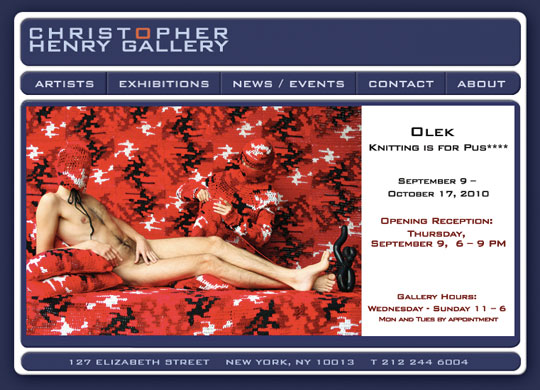 “OLEK: Knitting is for Pus****”
“OLEK: Knitting is for Pus****”
Christopher Henry Gallery
127 Elizabeth St., (Broome)
New York, NY
t.212.244.6004
www.christopherhenrygallery.com
Through October 17, 2010
Polish-born artist, Olek creates wild, and occasionally functional, structures from hundreds of miles of crocheted, woven, and often recycled materials, forms, and spaces. For this exhibition,the ChristopherHenry Gallery serves as the “home base” for Olek’s exhibit, a multi-media sculptural environment, featuring an entire room completely covered in crochet. Viewers may also follow her threads out of the gallery using a map to discover new objects she has crocheted and intertwined throughout the neighborhoods of NOLITA and L.E.S.
“Olek’s use of crochet has no relation to the world of craft,” reads the gallery’s press materials, “rather it is used as an alternative to other artistic mediums such as oil or acrylic on canvas. Its use can be interpreted as a metaphor for the complexity and interconnectedness of the body, its systems and psychology, and, in a broader sense, it can represent humanity itself. The connections are stronger as one fabric, as opposed to separate strands, but, if you cut one, the whole thing will fall apart. It also serves as a literal extension of the body, a second skin that can be stretched and reshaped. Olek’s use of crochet is not a feminist critique – her obsessive use of the medium, often denigrated as “women’s work”, combined with Olek’s recurring camouflage motif and the impressive scale of her projects, challenges traditional notions of gender, as she aggressively re-weaves the world as she sees fit. In a new series of text based works Olek contrasts the convenience and spontaneity of “txt msgs” to her time-consuming, laborious crochet, reevaluating the notions of privacy, communication, and technology while immortalizing the intense yet fleeting sentiments of modern relationships.”
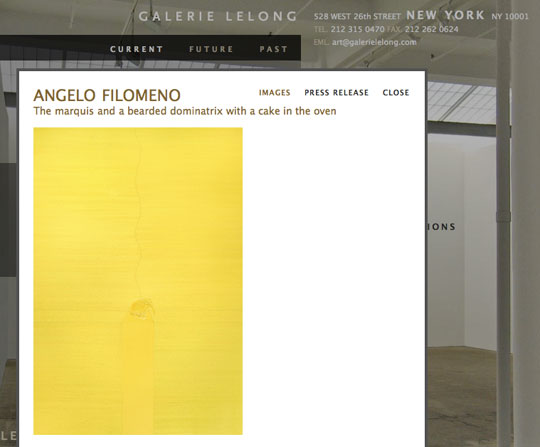 ANGELO FILOMENO:
ANGELO FILOMENO:
The marquis and a bearded dominatrix with a cake in the oven
Galerie Lelong
528 W. 26th St.
New York, NY
t.212.315.0470
www.galerielelong.com
Through October 23, 2010.
In The marquis and a bearded dominatrix with a cake in the oven, Angelo Filomeno presents new embroidery paintings and sculpture that exemplify his signature technique and fascination with the macabre. Fantastical and allegorical in imagery, and intricate in technique, Filomeno’s works are deeply informed by his upbringing in Italy. Filomeno learned to embroider from his mother and began apprenticing for a tailor when he was 7; his father was a blacksmith. From a young age, Filomeno formed a keen awareness of texture, composition, detail, and craftsmanship. He also developed an interest in the darker facets of the human condition: mortality, isolation, compulsion, fragility. These stark themes have pervaded his work, juxtaposed with the use of alluring, sensuous materials such as silk, black glass, and crystals.
In his newest exhibition, Filomeno pares down the ornate approach for which he is best known and presents sparser, more concise works that evoke the artist’s common themes with minimal means. Included are two large-scale mandalas, embroidered mosaics of stitched silk and satin in varying shades of yellow. The concentric rings of geometric patterns and bright yellow hues beckon the viewer to gaze deeper and deeper in to the piece, only to be confronted by a sinister skull and hoards of cockroaches hidden in their centers. Also on view will be a triptych of detached, decomposing heads of men he deems ‘philosophers,’ a character that he has revisited throughout his career as a paradigm of the harsh aspects of mortality and reflection. “The irony,” Filomeno has said, “is that these portraits represent death, but they are still thinking about their own existence.”
Maybe we’ll see you there.
In Progress: Helena Hernmarck’s Tabula Rasa
Here are rare in-progress images of Helena Hernmarck’s major commission for Pao Hall at Purdue University in West Lafayette, Indiana. The finished work will be approximately 10 x 14.5 feet and is due to be completed later this year. Hernmarck was recommended to the University by Lisa Lee Peterson. Peterson is an artist and professor in the Department of Art and Design in the Patti and Rusty Rueff School of Visual and Performing Arts at Purdue, where she has taught fiber arts and textile design for twenty-five years.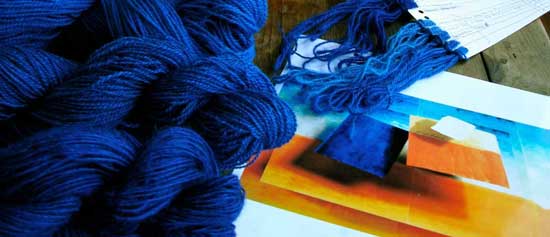
Dispatch: American International Fine Art Fair, Palm Beach, February 3rd-8th

Lenore Tawney collages, In Chaco and The Loftiest Word and sculpture, Boy with Duck, at AIFAF
From February 3rd to the 8th. browngrotta arts will join more than 80 international galleries exhibiting at the American International Fine Art Fair (AIFAF) in Palm Beach, Florida. AIFAF is recognized as the “crown jewel” of American art fairs and is the only American art and antiques fair rated 5 stars by The Art Newspaper. AIFAF is a fully vetted fair, featuring prestigious international dealers presenting a mix of paintings, sculpture, jewelry, antiques, contemporary design and decorative arts. In cooperation with the Baruch Foundation and the Lenore G. Tawney Foundation, browngrotta arts will feature the work of Magdalena Abakanowicz and Lenore Tawney at AIFAF, artists whose work redefined weaving and sculpture in the 20th Century.
Abakanowicz is the best-known Polish artist in the world. She initially gained acclaim for her “Abakans,” monumental woven works of sisal, ropes and other fibers that hung free in space. Next were headless human forms of burlap and later bronze. Large groupings of her sculptures are installed around the world, from Chicago’s Millennium Park to Olympic Park in Seoul to the Israel Museum in Jerusalem. In presenting her a Visionaries! award in 2000, the Museum of Arts and Design cited her for “her powerful explorations, dealing with the impact of social and political reality on individual identity, that have demonstrated the potential of fiber as an effective and expressive sculptural material.”

Weavings by Magdalena Abakanowicz at AIFAF. The weavings on the far right and far left were woven in the 1980s; the piece in the center is from the 1960s.
At AIFAF, browngrotta arts will exhibit three weavings by Abakanowicz, one from the 1960s and two, from the Anne and Jacques Baruch Collection, Ltd., created in the 1980s. The Baruchs opened a gallery in Chicago in the late 1960s, bringing work to the U. S. from Central Europe in order to give exposure to the Slavic art that Jacques, who died in 1986, once described as “the finest work of tomorrow…not what is known…the new blood.” Jacques was unable to travel after 1970, but Anne continued to travel to Central Europe to search for art. As the political situation in the area tightened, Anne, began smuggling art into the US, often at great risk. Government agents would seal her packages of approved art before she left; with the help of artists, she would often unseal the packages and reseal them in order to add unsanctioned works. She would travel with a bright red Hartman suitcase with a false bottom, filled with art supplies that the artists could not buy. On her return trip, artworks would be hidden inside. In this manner, Anne amassed a singular collection of contemporary textiles and historical and contemporary Czech photography. The Baruch Foundation was established in 2008, subsequent to Anne’s death in 2006 and is comprised of her personal art collection and the artwork inventory of The Anne and Jacques Baruch Collection, Ltd. The missions of the Foundation are to preserve and foster the growth of the visual arts of Eastern and Central Europe through donations of artwork to museums and schools, and to fund educational programs and scholarships by the sale of artwork.

Works by Lenore Tawney on display in the browngrotta arts booth at AIFAF.
At AIFAF, browngrotta arts will also show weavings, drawings, collages and mixed media assemblages by Lenore Tawney, who died in 2007 at the age of 100. “Luminous is an apt word to describe the entire career of the American artist Lenore Tawney,” wrote Holland Cotter in the New York Times in 2004. In the 1950’s, he noted, “she created a series of monumental open-weave sculptures that were like nothing seen before or since. Astonishing.” About her collages Cotter has written, “Whether she sets cut-up bits of handwriting spinning around a reproduction of a Michelangelo sibyl or turns strips of antique German books into suspended grids, she touches on the roots of the collage medium in language and personal history with a reticent orginality.” The Lenore G Tawney Foundation was established in 1989 by Tawney for charitable and educational purposes. Its aim is to support other artists in their own artistic efforts and to support special projects at art museums and non-profit educational arts organizations; its highest priority is to nurture emerging artists and to provide them with learning opportunities through established educational programs.
Search
Subscribe2
Recent Posts
- July 2, 2025
- June 25, 2025
- June 12, 2025
Pages
blogroll
Archives
- July 2025
- June 2025
- May 2025
- April 2025
- March 2025
- February 2025
- January 2025
- December 2024
- November 2024
- October 2024
- September 2024
- August 2024
- July 2024
- June 2024
- May 2024
- April 2024
- March 2024
- February 2024
- January 2024
- December 2023
- November 2023
- October 2023
- September 2023
- August 2023
- July 2023
- June 2023
- May 2023
- April 2023
- March 2023
- February 2023
- January 2023
- December 2022
- November 2022
- October 2022
- September 2022
- August 2022
- July 2022
- June 2022
- May 2022
- April 2022
- March 2022
- February 2022
- January 2022
- December 2021
- November 2021
- October 2021
- September 2021
- August 2021
- July 2021
- June 2021
- May 2021
- April 2021
- March 2021
- February 2021
- January 2021
- December 2020
- November 2020
- October 2020
- September 2020
- August 2020
- July 2020
- June 2020
- May 2020
- April 2020
- March 2020
- February 2020
- January 2020
- December 2019
- November 2019
- October 2019
- September 2019
- August 2019
- July 2019
- June 2019
- May 2019
- April 2019
- March 2019
- February 2019
- January 2019
- December 2018
- November 2018
- October 2018
- September 2018
- August 2018
- July 2018
- June 2018
- May 2018
- April 2018
- March 2018
- February 2018
- January 2018
- December 2017
- November 2017
- October 2017
- September 2017
- August 2017
- July 2017
- June 2017
- May 2017
- April 2017
- March 2017
- February 2017
- January 2017
- December 2016
- November 2016
- October 2016
- September 2016
- August 2016
- June 2016
- April 2016
- March 2016
- February 2016
- December 2015
- October 2015
- September 2015
- August 2015
- June 2015
- May 2015
- April 2015
- March 2015
- February 2015
- January 2015
- December 2014
- November 2014
- October 2014
- September 2014
- August 2014
- July 2014
- June 2014
- May 2014
- April 2014
- March 2014
- February 2014
- January 2014
- December 2013
- October 2013
- September 2013
- July 2013
- June 2013
- May 2013
- April 2013
- March 2013
- January 2013
- December 2012
- November 2012
- October 2012
- September 2012
- August 2012
- July 2012
- June 2012
- May 2012
- April 2012
- March 2012
- February 2012
- January 2012
- December 2011
- November 2011
- October 2011
- September 2011
- August 2011
- July 2011
- June 2011
- May 2011
- April 2011
- March 2011
- February 2011
- January 2011
- December 2010
- November 2010
- October 2010
- September 2010
- August 2010
- July 2010
- June 2010
- May 2010
- April 2010
- March 2010
- February 2010
- January 2010
- December 2009
- November 2009
- October 2009
- September 2009
- August 2009
Categories
- Acquisitions
- Aldrich Museum of Contemporary Art
- Allies for Art
- An Unexpected Approach
- Anniversary
- Architecture
- Art
- art + identity
- Art Assembled
- Art Materials
- art money
- Art Preview
- Art Textiles
- artist
- Artsy
- Awards
- bamboo
- Basketmakers
- Basketry
- Behind the Scenes
- Blue/Green
- Book Recommendations
- Books
- Catalogs
- Ceramics
- Charity
- Classes
- Collage
- Collectors
- Commentary
- Commission
- Commissions
- Danish Tapestry
- DIY
- Eco-Art
- Exhibitions
- Fashion
- Fiber Future
- Fiber Sculpture
- Film
- Galleries
- Gifts
- Guest Post
- History
- In the News
- Installations
- Japandi
- Japanese Art
- Japanese Ceramics
- Lectures
- Mixed Media
- Museums
- New This Week
- New York
- Obituary
- Obiturary
- Outdoors
- Paper
- Philadephia Museum of Art
- Photography
- Politics
- Pop-Up Exhibition
- Press
- Process Notes
- Sculpture
- SOFA
- Sweepstakes
- Tapestry
- tate modern
- Technology
- Text Art
- Travel
- Uncategorized
- Volume 50: Chronicling Fiber Art for Three Decades
- White
- White Art
- Who Said What
- Wood
- Workshops
Tags
Adela Akers art assembled Basketry browngrotta arts Carolina Yrarrázaval Caroline Bartlett Dorothy Gill Barnes Ed Rossbach Gudrun Pagter Gyöngy Laky Heidrun Schimmel Helena Hernmarck Hisako Sekijima Jane Balsgaard Jennifer Falck Linssen Jin-Sook So Jiro Yonezawa John McQueen Karyl Sisson Kay Sekimachi Kiyomi Iwata Kyoko KumaI Lawrence LaBianca Lenore Tawney Lewis Knauss Lia Cook Magdalena Abakanowicz Marian Bijlenga Mariette Rousseau-Vermette Mary Giles Mary Merkel-Hess Nancy Koenigsberg Nancy Moore Bess Naoko Serino Naomi Kobayashi Norma Minkowitz Rachel Max Randy Walker Sheila Hicks Stéphanie Jacques Sue Lawty Tamiko Kawata Tapestry Wendy Wahl Yasuhisa KohyamaAbout browngrotta.com
blogroll
reboot
site-ings
who's showing where
Subscribe
Pages
Archives
Calendar
July 2025 M T W T F S S 1 2 3 4 5 6 7 8 9 10 11 12 13 14 15 16 17 18 19 20 21 22 23 24 25 26 27 28 29 30 31

